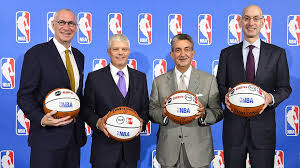 The NBA has again taken a monumental step forward in its business. In 2016 the league will enter into a new television contract that will more than double in size from the previous one. And since the TV revenue is the largest component of revenue that is counted as the total pot shared with the players (Basketball Related Income, or BRI) the effect on the salary cap is obvious.
The NBA has again taken a monumental step forward in its business. In 2016 the league will enter into a new television contract that will more than double in size from the previous one. And since the TV revenue is the largest component of revenue that is counted as the total pot shared with the players (Basketball Related Income, or BRI) the effect on the salary cap is obvious.
It’s going up.
Up is actually an understatement. The cap will be going into outer space.
The effect of the new revenue equation is already apparent. Just look at the jump that franchise values have taken. The salary cap is going to be so big that it’s going to change the way that both teams and players think about free agency. That’s what happens when you pour $24 billion into the system over nine years.
 Issue #1: How do you put this money into the system all at once without creating a feeding frenzy by the owners? The salary cap is projected to raise by over $20 million the first year and another $16 million the second year. What that means in real life is that those free agent classes will have a seller’s market. The raise in the salary cap will put almost all of the teams under the cap, able to bid on free agents. How can teams protect themselves from being raided by so many suitors?
Issue #1: How do you put this money into the system all at once without creating a feeding frenzy by the owners? The salary cap is projected to raise by over $20 million the first year and another $16 million the second year. What that means in real life is that those free agent classes will have a seller’s market. The raise in the salary cap will put almost all of the teams under the cap, able to bid on free agents. How can teams protect themselves from being raided by so many suitors?
The answer proposed by the league is euphemistically called “smoothing.” It sounds so nice, so soothing: Smoothing.
The proposal is to gradually ease the money into the system by artificially slowing the cap increases over the first three years of the new television deal. While this will slow the increases of the cap and salaries directly related to it (notably the max salary) there are several things that it won’t do.
So before you wonder why in the world the players would consider this at all, I’ll share a few of the rules.
Most importantly, smoothing WILL NOT reduce the total amount of money that will be paid to the players by one penny. It will only affect how it is distributed.
Under the current CBA the total revenue (BRI) is shared between the owners and the players by a complicated formula guaranteeing the players share to be between 49-51%. If salaries rise over this amount, then the players are required to return the overage via a system where part of their salaries are escrowed to be paid after all of this is calculated.
What has not gotten much attention is what happens if salaries fall beneath the guarantee. That’s because it hasn’t happened before. With BRI about to rise so quickly, the odds are that total league salaries won’t absorb the increase all at once. Historically, in years when the cap has taken large jumps (over 15% in one year), it has taken 3-5 years for salaries to fully adjust to the new cap. Partly this is due to the fact that only about one third of players are free agents each year, with many of those being minimum salary or journeyman players under one-year deals. Sometimes there just aren’t enough top free agents to use up all of the money at once.
When league salaries total less than 51% of BRI (the amount the formula guarantees under the current circumstances), a shortfall is created. In this circumstance the league must make a payment to the players union to be distributed to the players in an equitable fashion that is currently undefined.
 With the current television deal about to kick in, the league is already projecting this shortfall to be several hundred million dollars a year at the beginning. The major effect of smoothing would be to artificially slow the growth of the cap, reducing the growth of new contracts to available free agents.
With the current television deal about to kick in, the league is already projecting this shortfall to be several hundred million dollars a year at the beginning. The major effect of smoothing would be to artificially slow the growth of the cap, reducing the growth of new contracts to available free agents.
The extra money not paid to individual players as salary would not be lost. It would be paid to the players as a group as an additional shortfall. So instead of the approximately one-third of the league that are free agents getting bigger contracts than typical, the money would be distributed to all of the players based on some agreed-upon formula.
The following year would have a similar mechanism in place, and it would continue until the entire amount of cap increase is absorbed and balance is restored around year four of the TV deal. With the explosion of revenue already agreed to in the TV deal, the cap reductions would need to be somewhere between $10 and $15 million during the seasons affected. That means that when multiplied by the 30 teams, somewhere in the neighborhood of $300-400 million ADDITIONAL dollars would be paid to the players by way of a shortfall payment. Which leads to…
Issue #2: How do you distribute all of that money fairly to the players? Now the union has to try to keep everyone happy. There are a couple of obvious ways to distribute the money.
Plan 1: Even Steven. The simplest and most likely plan is to take the pot and divide it evenly among all players. This option is typically how extra money is distributed. For example, currently the players receive a large pot of money from a license agreement with the NBA. This money is distributed evenly among all players annually. The shortfall is projected to be so big that each player would receive a bonus check of around a million dollars.
Plan 2: Pro rata. This system would distribute money to the players in direct proportion to their current salary. It essentially gives all players the same percentage bonus. The highest earners would receive the largest shortfall payments.
There will be a large shortfall whether smoothing is adopted or not. This plan will only affect how large the shortfall will be.
Issue #3: Complicating factors: All of this is going on in the middle of the collective bargaining negotiations. There are so many other things on the table that its tough to know how this issue will fit into the big picture. Here are a few of the big ones:
• The rookie scale, mid level exceptions, and veteran minimum contracts are not tied to the cap. All of these contracts are set by existing tables created during the current deal when the league was crying poverty. These contracts may be considered undervalued in tomorrow’s salary environment.
• Contract increases are also set based on the current deal. The annual increases are set at between 3-7½% depending on the type of contract. League revenues are going up much faster than that.
• The age limit question is still unresolved. The league is pushing for an age limit of 20, eliminating the One and Done issue (which I covered in this post).
 These plus many other issues will be hashed out. The current CBA has an opt-out clause in 2017. It may or may not be reopened, although Michele Roberts told Chris Sheridan she is proceeding with the expectation that the players will opt out. It’s possible that the issue of smoothing will be negotiated on its own merits. One thing is certain though. It can only be advanced by agreement of both sides.
These plus many other issues will be hashed out. The current CBA has an opt-out clause in 2017. It may or may not be reopened, although Michele Roberts told Chris Sheridan she is proceeding with the expectation that the players will opt out. It’s possible that the issue of smoothing will be negotiated on its own merits. One thing is certain though. It can only be advanced by agreement of both sides.
In the big picture the issue may be relatively moot. After all, over the last several years, teams have been tremendously disciplined in managing their cap space by shortening contracts and massaging their rosters. Many teams already match players up to ensure that they can have cap space providing flexibility to play in the free agent market. As always, supply and demand will eventually reach balance.
There have been several years with few teams under the cap causing a tightening of opportunities for players. The first few years of the new TV contract increases revenue and will allow many more teams to be under the cap.
But that doesn’t mean that every team will spend foolishly on a limited number of top players. Over the course of the last few collective bargaining negotiations, the league has taken large steps to limit spending by teams. Even with the new revenue coming into the picture, it is likely that things will smooth out naturally.
Danny Schayes is a Director of Business Optimization at Intensity and a leader in the business of professional sports. Schayes frequently advises sports organizations in complex business matters that include contract negotiations, pricing strategy, marketing optimization, and executive leadership. Follow him on Twitter.
